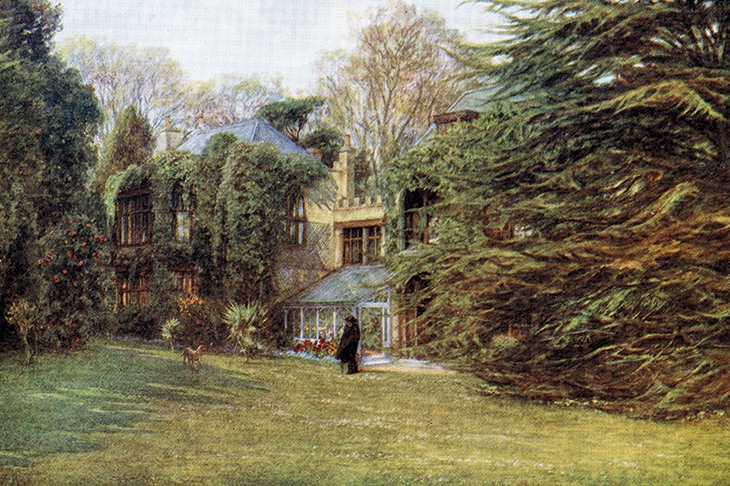If you seek out the home of an admired writer, you might find, as with Ernest Hemingway’s house in Havana, that there’s a pen on the desk, mid-novel, and it feels as though he’s about to return from a day’s fishing. You might encounter, as Hermione Lee did visiting the novelist Elizabeth Bowen’s beloved ancestral home in Ireland, only a pile of grass and stones, because the building has been razed to the ground. Or you might discover, as Kate Kennedy did seeking out the Gloucester mental asylum where the poet and composer Ivor Gurney was incarcerated, that it has been turned to a new use. The chapel of Barnwood House Hospital is now a makeshift gym, and Kennedy watched as men sweated and grunted beneath the wooden hymn board, still listing the hymns for the final service.
Writers’ homes are, as Lee says in the introduction to this thoughtful, meticulously edited collection of essays, a crucial part of their life:
How a house is lived in can tell you everything you need to know about people, whether it’s the choice of wallpaper, the mess in the kitchen, the silence or shouting over meals, doors left open or closed, a fire burning in the hearth.
The sea pours into Benjamin Britten’s house at Aldeburgh, reminding us of the perils of living by the coast
All biographers must explore their subjects’ home, or lack of home, and this collection will be an invaluable resource for those thinking through these questions in future.
It also allows readers to enter the houses of writers they love alongside a group of particularly eloquent and reflective guides. There are 23 pieces here, many of them reflections by biographers on their research, with a few poems, investigative essays and memoir pieces thrown in. All are attentive to the details of home-making, peeling away the layers of change across the centuries, from Roman times to the present, as they attend to what it feels like to move house, to lose a home, to return to the lost world of childhood, or to think, as Edith Wharton did, of our bodies as a kind of home: ‘In the innermost room, the soul sits alone and waits for a footstep that never comes.’
Among the writers whose homes are examined are Wordsworth and Coleridge, Tennyson, Auden, William Cowper, H.G. Wells and Edward Lear. There are composers in the mix: Benjamin Britten, Sibelius (reflected on by Julian Barnes), and Gurney. And there are essays on two prime ministers: Disraeli and Churchill. If this sounds like a roll-call of great dead white men then that’s broadly accurate, though there are welcome appearances by Virginia Woolf, Penelope Fitzgerald and Edith Wharton and a brief blast of colour in Elleke Boehmer’s powerful essay on the Zimbabwean writer Dambudzo Marechera.
Collectively, the essays remind us how much experiences of home have changed across the centuries. Alexandra Harris, for example, brings alive how it felt to move house in the 18th century, when in Britain there were set moving days, a few times a year, and on these you could see processions of wheeled belongings thronging the streets as tenants ‘flitted’ from house to house. Lucy Walker shows us the sea pouring into Benjamin Britten’s house in Aldeburgh, reminding us how perilous living by the coast can be.
Along the way, there are questions asked, and ones evoked more implicitly by the collection as a whole. What is the value of displaying dead writers’ houses as museums? Can the stately homes of the past be, as H.G. Wells ambivalently believed, the places where modern civilisation was begotten and nursed? What ideas of community can be centred in home-owning? Do we share Britten’s view that ‘roots are especially valuable nowadays, when so much we love is disappearing or being threatened’? Is there more value in rootedness of this kind or in the more cosmopolitan refusal of roots we can see here in W.H. Auden?
Of course not everyone has a choice in this, and for me the most powerful essays were the three tackling homelessness head on. Alexander Masters surveys some of the people in a shelter in Eastbourne, juxtaposing the man who finds living within walls too claustrophobic to contemplate again with the woman who longs for a home: ‘You can have a cup of tea and think about doing positive things instead of where you are going to walk today.’
Elleke Boehmer examines Marechera’s period of living in a tent on an Oxford meadow after being sent down from the university, asking eloquently what it means to be homeless ‘both actually and in terms of a national tradition to call his own’. And Kate Kennedy’s moving essay on Ivor Gurney is attentive to the different forms of displacement he suffered as he moved from one asylum to the next, dreaming of a long-since tarnished image of home.






Comments